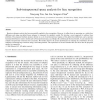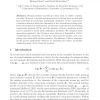1086 search results - page 18 / 218 » Subspace Analysis Using Random Mixture Models |
IJON
2006
13 years 7 months ago
2006
Bayesian subspace analysis has been successfully applied in face recognition. However, it suffers from its operating on a whole face difference and using one global linear subspac...
IDEAL
2005
Springer
14 years 1 months ago
2005
Springer
Abstract. Normal mixture models are often used to cluster continuous data. However, conventional approaches for fitting these models will have problems in producing nonsingular es...
TMI
2010
13 years 2 months ago
2010
Within-subject analysis in fMRI essentially addresses two problems, the detection of brain regions eliciting evoked activity and the estimation of the underlying dynamics. In [1, 2...
CVPR
2003
IEEE
14 years 9 months ago
2003
IEEE
When performing subspace modelling of data using Principal Component Analysis (PCA) it may be desirable to constrain certain directions to be more meaningful in the context of the...
ISBI
2009
IEEE
14 years 2 months ago
2009
IEEE
—We present iCluster, a fast and efficient algorithm that clusters a set of images while co-registering them using a parameterized, nonlinear transformation model. The output of...



